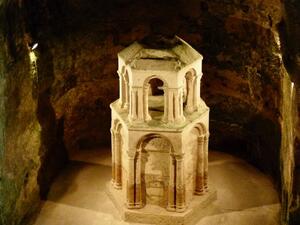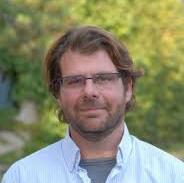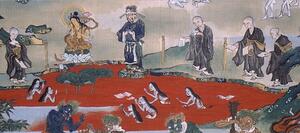Sacred Underground Symposium
Friday, October 28
10:00am to 5:30pm
In-person: ACB 238
- Lisa Bitel “Stuck in the Iron Age: The Buried Otherworld of Early Ireland”
Respondent: Jennifer Jahner
- Jay Rubenstein “Raiders of the Lost Patriarchs.”
Respondent: Alison Perchuck
- Carolyn Laferriere Paper: “Making a Case for Caves: The Cult of Pan in Athens.”
Respondent: Ann Marie Yasin
- Dyan Elliott “Grave Events: Exhumation in the Early Middle Ages.”
Respondent: David Albertson
- Jennifer Hughes “Paying Tribute for the Dead: Religion and Spectral Labor in Sixteenth-Century Mexican Epidemics”
Respondent: Marie Kelleher
- Sarah Semple “Early Medieval Conceptions of Sacred Space and Place: Holes, Hollows, Caves and Hellmouths in Early Medieval Practice and Imagination”
Respondent: Maya Maskarinec
Advance registration is required. Please register at the following link.

“A prophet in his own country”: Varro’s Sacred Spaces
Monday, November 8 2:00pm – 3:30pm PDT
in-person: SOS 250 | on-line: please register HERE
Speaker: Joseph McAlhany University of Connecticut
In praising the intellectual achievements of his contemporary Marcus Terentius Varro, Cicero emphasized that Varro’s writings allowed Romans, who previously experienced the physical landscape of their city as nothing more than tourists, to finally know where and who they were. But if Cicero viewed these compilations of antiquarian information as a guidebook of sorts to the city and its sacred spaces, for Varro they were the creation of an alternative Eternal City he could inhabit, beyond the corruption and decay of Rome. Throughout his mostly fragmentary and wide-ranging corpus, including his major scholarly works on the Latin language and Rome’s religious and historical traditions, Varro fashioned a second life in letters not as savior of the city’s past, but prophet of its doom, culminating in his odd swan-song to his homeland, the pseudo-agricultural treatise De re rustica.

Etiologies of Women’s Suffering: Doctrinal Engagement with the Blood Bowl Hell in Late Medieval Japan
Friday, February 19 at 3:00pm (PT)
Please register HERE
Lori R. Meeks Associate Professor of Religion and East Asian Languages and Cultures
The apocryphal Buddhist Sutra Xuepen jing (“Blood Bowl Sutra”), produced in China during the eleventh or twelfth century, was imported to Japan by the early fifteenth century, where it came to be known as the Ketsubonkyō. This short text—only about 420 Chinese characters long—taught that women were bound for a special, purgatorial hell comprised of uterine blood. They were to be punished there for having polluted the earth with the blood of childbirth and menses. Cults to the sutra spread widely in Japan and became the basis of many devotional practices aimed both at saving women from the hell and at providing protection during the travails of female embodiment, especially childbirth.
Many have claimed that the Blood Bowl Sutra was always regarded as a “popular” text and that it was never taken seriously by the orthodox tradition; after all, it is short, clearly apocryphal, and lacking in doctrinal sophistication. This paper challenges that stance, demonstrating the degree to which Japanese monastic scholars, especially those of the Tendai establishment (which was widely acknowledged as the intellectual hub of premodern Japanese Buddhism), presented the ideas of the Blood Bowl Sutra as consistent with mainstream Buddhist doctrine. I also argue that these same priests were at least partially responsible for popularizing the sutra’s contents in vernacular literature.
The paper will be pre-circulated for registrants to read prior the discussion.

“Moving through Sacred Ground: Dance and Gesture in Relief Sculpture.”
By CPW Postdoctoral Fellow, Dr. Carolyn M. Laferrière
Monday, November 16 – 4:00pm (Pacific)
PLEASE REGISTER HERE
Going beyond the conventional association of sacred ground with religious sanctuaries and their landscapes, first-century BCE Neo-Attic reliefs from ancient Greece challenge us to locate sacred ground in the visual planes in which stylized mythological scenes occur. Current scholarship on this corpus of reliefs has focused on establishing typologies, chronologies, and iconographies; the reliefs’ theological and aesthetic significance, however, has been largely overlooked. How might we understand the significance of the distinctive visual style used in these images of divine and mythological subjects? Do the archaizing scenes attempt to recapture an idealized, yet lost and remote, religious landscape? Or do they draw upon Archaic and Classical religious imagery that visually established connections between human and divine beings, in order to elaborate new aesthetic modes of experiencing the divine? Dr. Laferrière will argue that the gods’ interconnected gestures and postures depicted on Neo-Attic reliefs determine the boundaries of the sacred ground that surrounds them, even as their expressive movements expand the limits of that space, offering their viewers an immersive experience of sacred ground as mediated through visual representation, music, and dance.

Setting the Scene and Referring to the Script: Aristocratic Performance and the Eastern Theater of Crusading Conflict”
Wednesday, October 14 4:30PM (PST) | Zoom
What function did the sacred ground around Jerusalem, conquered by European crusaders in the eastern Mediterranean, play for the elites who expended their blood and treasure to sustain them? Answers to this question have traditionally sought recourse either to materialist, proto-colonial expansion or to Catholic religious zeal. Adopting a new perspective based on the specific prerogatives and requirements of the European aristocracy, Professor Paul will suggest that the eastern Mediterranean “theater of war” was precisely that: a stage for the performance of status. It will be argued that some of the most famous cultural monuments of the French-speaking crusader aristocracy of Syria, Palestine, and Cyprus reveal how this stage was set, and how visiting players from the European courts were invited to perform their parts.

